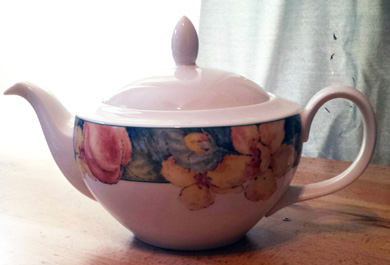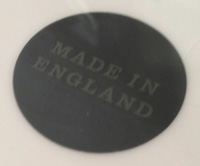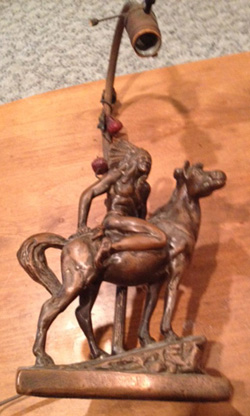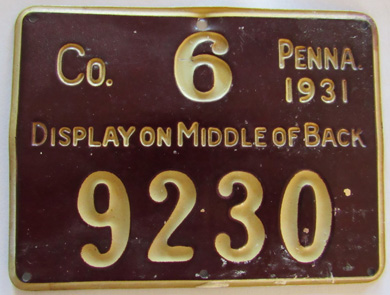 |
|
|||
 |
 |
|||
Copyright © Harry Rinker, LLC 2016 Questions
and Answers
QUESTION: I recently purchased a teapot from a thrift shop and am having trouble identifying the maker. The only mark is a solid black circle with the words “MADE IN / ENGLAND” in yellow inside the circle. It appears there is another backstamp or writing underneath, but I cannot make it out. At first glance, the teapot appears to be a “Georgia” pattern teapot from Royal Doulton’s Everyday collection. Upon close inspection, I found some inconsistencies. The most obvious was the lack of a Royal Doulton mark. The teapot lid in the Royal Doulton’s Everyday line has a patterned center green ring. What do I have – a reproduction, copycat, or fake? My thought was that if it was a fake, there would be a pseudo-Royal Doulton mark. Any insight you have will be greatly appreciated. – HC, Monmouth, NJ, Email Question
ANSWER: I checked out the “Georgia” pattern teapot from Royal Doulton’s Everyday collection. The lid is not the same, but the body shape and decoration of the teapot are identical. This eliminates reproduction (an exact copy of a period piece) and copycat (a stylistic copy of a period piece). All the examples I found contained the same pattern as your teapot. I found slight variations in the quality and painting, a result of hand painting the decorative motif rather using a decal.
What actually happened? My suspicion is that someone (an unscrupulous importer or retailer) placed a fake “MADE IN / ENGLAND” stamp over the Indonesian mark and glazed over it. There are ceramic glazes today that air dry or dry quickly in the mild heat of an oven. The motive behind the fake mark is to cater to the American buyers who believe English ceramics are of a higher quality than ceramics made elsewhere. Therefore, they should sell at a higher price. The lid is a generic replacement lid that closely matched the “Georgia” pattern lid. Perhaps the individual altering the piece felt this change was enough to avoid a pattern copyright infringement claim. The Royal Doulton “Georgia” pattern teapot sells on the secondary market for around $80.00, more than its initial selling price. The margin does not have to be large to tempt individuals to alter marks and other characteristics of an object to create a perceived higher value. Since you purchased it at a thrift shop, I assume you paid $5.00 or less. Assuming this to be the case, use your teapot to brew a pot of tea and enjoy a few “biscuits” or shortbreads.
ANSWER: The founding date for Armor Bronze is subject to dispute. Some claim an origin dating back to 1880. Others favor a 1910 dated. A 1915 print advertisement indicated Armor Bronze, initially The National Metalizing Company (dropped as the company name in 1920), had a main office and factory in Garwood, New Jersey and a studio/showroom at 333 Fourth Avenue in New York City. The company made bookends, doorstops, figurines, lamps, sculptures, trays, and other metal products in bronze and bronze plating. The company was located in Taunton, Massachusetts in 1934. In 1946, Armor Bronze Company became Armor Bronze and Silver Company, the latter ceasing operation in 1950. [See: http://www.antiquebookends.us/pg/makers-bronzeclad.php and http://antiquebookends.net/armor.htm.] A pair of Armor Bronze bookends using the identical Native American figure, albeit the war bonnet is enameled/painted, are listed on eBay for a “Buy It Now or Best Offer” of $494.00. The seller notes: “a perfect addition to your Western collection.” Using the same cast figure for bookends and lamps was common. Many companies did it. The initial production cost was the mold. Once the mold was created, it was in the company’s best interest to find multiple uses for the figure cast from it. A Google search produced images for a number of Armor Bronze lamps. None were identical to the example that you own. If there are collectors for Armor Bronze lamps, I am unaware of them. Bookend collectors view lamps as peripheral material. The lamp’s strongest appeal is to a Western/Native American collector. Your lamp’s value is between $150.00 and $175.00 in the Plains and Southwest states. Elsewhere, deduct $50.00. QUESTION: A decade or so ago, I paid $100 at a charitable auction for a home plate signed by Alex Rodriquez. A card that accompanied the plate indicated that it symbolized Rodriquez’s 40th home run and 40th stolen base. What is it worth? – D, Bozeman, MT ANSWER: Alexander Emmanuel “Alex” Rodriquez was drafted out of high school by the Seattle Mariners in the 1993 Major League Baseball draft. He made his major league debut in 1994. He joined the Texas Rangers in 2000 and was traded to the New York Yankees in 2004. While unfamiliar with Major League Baseball team loyalties in Bozeman, Bozeman’s geographic location suggests a strong connection with the Seattle Mariners. Assuming the information on the card is correct, the home plate dates from Rodriquez’s early career. Rodriquez is one of the modern players who has admitted to using performance enhancing drugs. While under normal circumstances he would be an automatic shoo-in for the Baseball Hall of Fame, the cloud surrounding him leaves this open to question. In the “what do I know about the secondary market for player signed home plates,” I received an education researching your topic. There is a strong primary collector market for game used, signed home plates. The website www.steinersports.com’s average asking price for an Alex Rodriquez signed and inscribed home run Yankees game used home plate ranges from $1,249.00 to $2,499.99, proof once again that “fools and their money are soon parted.” None of these player signed home plates have stood the test of time on the secondary market. You need to have the signature on your plate authenticated. It is a recognized fact that over 85 percent of signed charitable auction sports memorabilia is signed by clubhouse personnel rather than the athlete. Should this prove to be the case, value is minimal. If the Rodriquez signature is authentic, then consideration has to be given to its value associated with Rodriquez as a Mariner as opposed to the value of his things as a Yankee. If you plan to hold on to your Rodriquez signed home plate, whether Rodriquez is elected to the Baseball Hall of Fame is a value factor. At the moment with the signature unauthenticated, it is likely that an individual would risk $200.00 to $300.00 at auction on eBay to acquire it – perhaps even more if two spirited Rodriquez/Yankee collectors were involved in the bidding. If the signature is authenticated, value at the moment is between $400.00 and $500.00. QUESTION: While remodeling our living room, my wife and I found a metal 1931 Pennsylvania hunting license. The metal license reads: “Co. 6 / PENN /1931, / Display on Middle of Back / 9230.” What is its value? – T, Berks Col, PA, Email Question
ANSWER: Although small in number, there is an avid group of sports enthusiasts who collect fishing and hunting licenses. Most focus on a single state. Early fishing and hunting licenses came in a variety of forms – canvas, leather, and metal. High-end value usually focuses on the first five years. There is a wide variety of hunting license types – resident, non-resident, special use, special deer, junior, senior muzzle loader, archery, bear, military, bobcat, elk, and more. Because of this, collectors narrow their collecting focus. According to information found on www.oldtacklebox.com the first resident hunting license was issued by Pennsylvania in 1913. It was a canvas license with accompanying paperwork. It is scarce and sells for over $2,000. In 1924, Pennsylvania switched to aluminum. Tin plate replaced aluminum in 1927. A No. 6 County license is for Berks County. County number has a minor value impact. Some counties issued fewer licenses than others. Pennsylvania licenses issued after 1945 have minimal value. Your 1930 PA tin plate residence license is worth between $30.00 and $40.00.Harry L. Rinker welcomes questions from readers about
collectibles, those mass-produced items from the twentieth and twenty-first centuries.
Selected letters will be answered in this column.
Harry cannot provide personal answers.
Photos and other material submitted cannot be
returned.
Send your questions to: Rinker on Collectibles, 5955 Mill
Point Court SE, Kentwood, MI 49512.
You also can e-mail your questions to
harrylrinker@aol.com.
Only e-mails containing a full name and mailing address
will be considered.
You can listen
and participate in
WHATCHA GOT?, Harry’s
antiques and collectibles radio call-in show, on Sunday mornings between 8:00 AM
and 10:00 AM Eastern Time.
If you
cannot find it on a station in your area,
WHATCHA GOT?
streams live on the Internet at www.gcnlive.com.
SELL, KEEP OR TOSS?: HOW TO DOWNSIZE A HOME,
SETTLE AN ESTATE, AND APPRAISE PERSONAL PROPERTY
(House of Collectibles, an imprint of Random House Information Group, $17.99),
Harry’s latest book, is available at your favorite bookstore and via
www.harryrinker.com.
|
||||

 The backstamp is a challenge. Royal Doulton’s “Georgia” pattern teapot was manufactured in an Indonesian factory. Hence, it could not be marked “Made in England.” I suspect the writing under the “Made In England” relates to its Indonesian factory origin.
The backstamp is a challenge. Royal Doulton’s “Georgia” pattern teapot was manufactured in an Indonesian factory. Hence, it could not be marked “Made in England.” I suspect the writing under the “Made In England” relates to its Indonesian factory origin. QUESTION: I have an Armor Bronze lamp featuring a three-dimensional figure of an Indian on horseback. According to the family story, my great grandfather bought the lamp in Akron, Ohio, around the turn of the 20th century as a reminder of his Native American heritage. I replaced the period cord more than 50 years ago. I found Armor Bronze bookends with this same motif. What information can you provide? – DP, Email Question
QUESTION: I have an Armor Bronze lamp featuring a three-dimensional figure of an Indian on horseback. According to the family story, my great grandfather bought the lamp in Akron, Ohio, around the turn of the 20th century as a reminder of his Native American heritage. I replaced the period cord more than 50 years ago. I found Armor Bronze bookends with this same motif. What information can you provide? – DP, Email Question